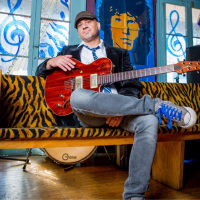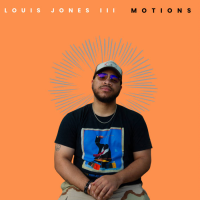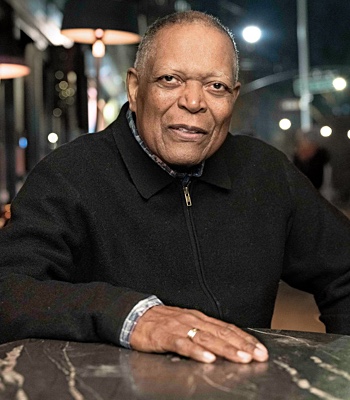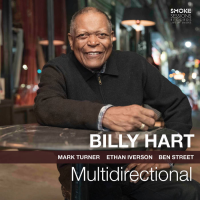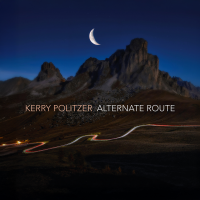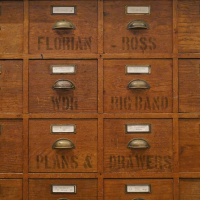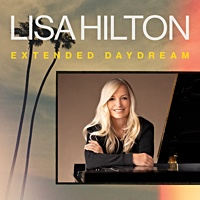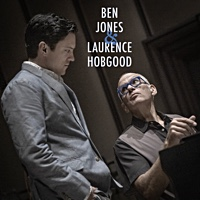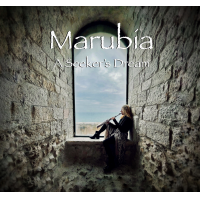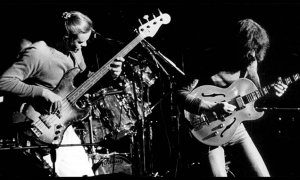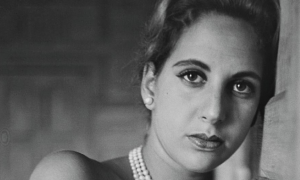Home » Jazz Articles » Chats with Cats » The Audiophile: Adrian Butts
The Audiophile: Adrian Butts
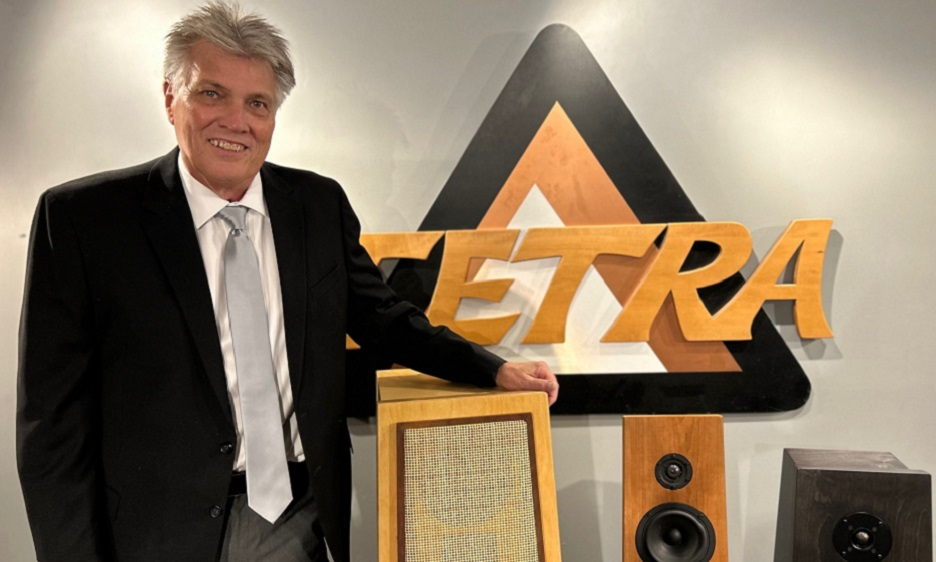
Courtesy Jena Cameron
I do not consider myself someone who works in the audio industry, per se. Instead, I say I’m in the music business. Therefore, anyone who loves music above and beyond their gear is our intended demographic.
—Adrian Butts
And yet, there is always a small group of audiophiles who will not accept this sonic mediocrity and continue to seek out a higher standard. For all the attention that goes into the recording end, we, the listeners, should do a better job of trying to hear their hard work. On the rare occasions I have had the opportunity to listen to music on a high-end system, my appreciation and immersion for that work is always far greater.
One individual fighting this battle is Adrian Butts, who has been fascinated by audio equipment since his earliest days. His love and interest in the mechanics of reproducing sound have led him to become President and Head of Design for Tetra Speakers, a company that considers its speakers to be another instrument made for perfecting the listening experience.
About Adrian Butts
Adrian Butts is the founder and chief designer of Tetra Speakers Incorporated in Ottawa, Canada. From an early age, Adrian has been passionate about sound and music. At the age of ten, he took apart his father's vintage speakers, curious to understand how they worked. As a teen, he owned a mobile disco and DJ'd at the local roller rink. He became an internationally top-ranked salesman for the prestigious speaker brand Bang and Olufsen and owned an audio store before the age of 30. Still unsatisfied in his pursuit of sound excellence, Adrian experimented with his own speaker design. He spent three years testing and understanding speaker components and cabinet design before launching Tetra Speakers in 1998, the culmination of his sound journey. Tetra Speakers creates "listening instruments" that capture the hearts and ears of musicians and music aficionados from around the world.Adrian attended Trent University for Cultural Studies and spent twenty years in the audio industry searching for sound perfection. He is the founding owner of Tetra Speakers, Inc. and Artet audio cables.
All About Jazz: Tell me about your journey into building speakers.
Adrian Butts: My journey in audio began at the age of two. I was fascinated by the magic of sound reproduction from an early age. My father had three different audio systems scattered around our house. In the basement, he had built a drawer that had a record player with a stacking 45 rpm spindle on it and a small 'smelly' tube amp. It was the early '60s, so transistors and red LEDs were not yet on the market, but more on this later. Beside the electronics drawer, he had made a good-sized speaker that was mounted on the wall. Unlike his iconic, and still prized today, Fisher 500-C amplifier and his Dual turntable, which was secreted away in a living room cabinet high up on the wall, powering his floor-standing Wharfedales, was this small basement system that I could easily access and did so obsessively. Thus began my music-loving and ultimately speaker-designing journey.
As I grew, much to my dad's chagrin, his big system became accessible to me, and that's when my 'hobby' really took flight. First, I pestered my dad to trade in his 'smelly' Fisher 500-C for the new frontier technology of the cool-running transistor amplifier with the high-tech red LEDs. He went along with me and when we brought the Fisher to the audio store and put it on the sales counter and explained what we wanted to do, trade in the Fisher, the store owner quickly disappeared the Fisher into the back and brought forward a brand new in-the-box transistor amp with red LEDs which he put on the counter in its place. Straight trade. Mission accomplished... I thought. Back home now and disappointed with the sound of his Wharfedales, which was now sounding so strident and harsh with the new transistor amp, that at ten years old my brain said to me, 'Well then...it's got to be the speakers.' My next move was to remove the woofers from his Wharfedale speakers, and I began the task of cutting the crossovers apart, trying to get back to where we once belonged with the tube amp. I had no idea what I was doing, uncertain if I was at risk of being shocked, but sadly, my well-intentioned tweaking fixed nothing. It was then that I began ordering speaker building kits with all my available funds at one point, even ordering a KEF kit from England, which included heavy 1" MDF wood and all the woofers, midranges, and tweeters (drivers). Being out of funds with shipping and duties added to the cost, I passed on purchasing the KEF crossover and opted for an off-the-shelf crossover from a local electronics store. That was another fortunate mistake. My fascination with speaker crossovers and frequency-dividing networks, which I learned was essentially the central nervous system of a speaker, was awakened.
After three years at university, my first job was at an Audio Shop. The store sold all the latest and greatest, including McIntosh, Nakamichi, and Bang & Olufsen. My sales ability was tops, and in several short years, I graduated to owning the store at twenty-nine. One thing that really bothered me about my sales vocation was that, try as I might, I could never make a sale to a professional musician, and that fact made me question my very existence. The economic downturn in the early '90s saw the store and me go bankrupt. It was a difficult time, but on the last day of store ownership, I remember saying out loud to myself, "It's ok, Adrian...you're not doing what you're supposed to be doing."
After my bankruptcy, I was approached by an industrial designer named Wayne Prince, who had a Tetrahedron design (an equilateral pyramid) for a speaker cabinet, and he asked me if I could make it work. My response was that my experience in the wonder years had shown me that I didn't know anything about crossover design. Still, fortunately for Wayne, I had maintained a friendship with a customer from my audio shop who I knew worked at the National Research Council in Ottawa, and perhaps he could help. The friend agreed to give it a go, and he promptly chose the drivers for the cabinets and ordered several speaker crossover design software packages from California. Unfortunately, the software calculations were not capable of designing a crossover that I knew I couldn't sell for even the parts cost, let alone adding a markup.
After three years of waiting for the man to come up with a suitable crossover, cabinetmaker Wayne Prince called me and asked me to visit his place in the country. Upon my arrival at Wayne's, I noticed that he had stacked up his prototype pyramid cabinets in the fire pit. As I approached the pit, I watched Wayne douse them with gasoline and then toss a match on the small mountain of tetrahedron cabinets. I watched the fire lap upwards for a New York minute and then made the fateful decision to grab the top two cabinets from the fire and throw them in my car. I drove away, saying to Wayne I don't know how I'm going to do it, but I guess I'm a crossover designer now.
My foray into making a crossover began with me sitting in the library reading white papers on the dos and don'ts of designing them. The white papers provided me with some tips on what to consider, but they didn't ignite a spark within me on how to tackle creating a crossover. In the end, it was a small book that I purchased from RadioShack that was the impetus for me moving forward with the design process. The book had one line that stated there are two ways to design a crossover. First, you can either purchase a ton of parts (coils, capacitors and resistors) and listen to them by trial and error but that this method of actually listening as you go takes both time and money and in the end it likely won't be successful at coming up with a good crossover or second, I could order their software package and make short work of it. And that was it. I was twigged, so I chose the design option one, and I proceeded to order a boatload of parts. I spent the next three years on my hands and knees listening to different part combinations. I was happy that I could even make it work at all, but my long-suffering wife Jena stopped participating in any listening sessions because the sound hurt her ears. Not good. I figured I was 10,000 hours into part listening, and then something magical happened.
I had a dream that I can only describe as a divine intervention. You see, in this realistic dream, I found myself travelling through darkness on the crossover wires, and I could see all the energies flowing and the bottlenecks that I needed to address. I can only describe it as like the movie A Fantastic Voyage. There was even a soundtrack as I travelled. No kidding, it was Peter Gabriel's song 'And through the wires.' I woke from that cosmic dream at 2 a.m. and went immediately downstairs and cobbled a mittful of parts into a crossover. I turned my stereo on and... BAM! There it was, and that ol' Tetra magic was born.
AAJ: One of your selling points is that your speakers are distortion-free. Explain to a novice like me what that means and why it's such a breakthrough.
AB: Distortion is defined as a change in the form of an electrical signal. In the case of, let's say, a bass woofer, its large diameter has a limited higher frequency range, and if you listen to just a woofer without a filter that works to remove the highs from the signal path, then the high frequencies will still enter the woofer. They will end up distorting the woofer and make what I describe as a 'fuzzy' sound. The same thing happens when you apply full frequency to a tweeter, because tweeters can distort and even be destroyed by the bass frequencies without a filter that removes the bass from the full-range signal.
A crossover in a two-way speaker (woofer and tweeter) is made up of two filters. One filter limits the high frequencies from going to the woofer, and the other filter limits the low frequencies from going to the tweeter. Therefore, the frequency points I choose for a crossover must be selected to remove all distortion or 'fuzz' from each driver used in the speaker design. The trick is to utilize all the frequencies available from the amplifier with the perfect roll-off amount that doesn't excessively lower the overall efficiency or volume of the speaker.
The fact that Tetra designs don't have any resistors or 'volume limiters' further ensures even less distortion. A good crossover design will make the space between the notes quieter with less overhang or 'fuzz' and therefore more of the ambience of the space where the recording was made is apparent. As Tetra owner Herbie Hancock said about one of his recordings, he thought that a note he knew he had played in the studio was edited out. Still, when he played that same recording on his Tetras, the note was miraculously back in all its glory. Obviously, the entire note gone from a recording is a no-no. Similarly, NAC orchestra concertmaster Walter Prystawski, after listening to a recording he played on through Tetras, remarked, "You can hear everything...even the junk!!" So, yes, distortion kills the sound of recorded music, and it is not welcome in our Tetra designs.
AAJ: Is there still new ground to pioneer when it comes to designing speakers, or is it just a pursuit to improve the existing technology?
AB: That's an interesting question. For me, I don't believe that there is anything new under the sun, so I plan to spend my time going forward using the driver technologies that are readily available and applying my crossover design 'gift' to create new models that achieve the exact sound of music results. I say this, even though I was involved in a technology company in the early '90s that developed digital wireless transmission and digital amplification, which we demonstrated at CES. The technology we developed ended up becoming a part of a well-known streaming hardware company. But that's not for me. I have since designed and manufactured our proprietary Artet (Tetra backwards) distortion-free wires. In my mind, the result of using our proprietary wire with Tetra speakers could never be duplicated by transmitting digital audio signals through the air.
AAJ: You associate yourself, specifically, with a lot of jazz music and jazz musicians. Why is that?
AB: I consider myself lucky for that fact. Meeting the jazz musicians who have ultimately become Tetra listeners (Willard Jenkins calls us Tetrans) and being on the level due to that thing that Tetras do has enriched my life immensely. It was a professor of music at Carleton University who first made the connection between Tetra and jazz. His name is Wayne Eagles, who is a lovely man and Canada's first to teach rock guitar and fusion ensembles at the university level. Part of Wayne's tenure sees him bringing in jazz musicians to the university to hold masterclasses and perform shows. It so happened that Dave Holland was one of those musicians, and after Wayne first heard Tetras, he invited Dave to visit Tetra and lend an ear. It was an invitation that Dave accepted.
Upon his arrival at Tetra, Dave understood Tetra's take on music rejuvenation right away. As it turned out, Dave was playing with Herbie Hancock and Wayne Shorter at the Ottawa Jazz festival that night. I received tickets and backstage passes from Dave, and then Wayne, and I drove him back to his hotel to get ready for the show. After the wonderful show, I went backstage, and Herbie entered the trailer where Wayne Shorter, Wayne Eagles, and I were alone. When Herbie entered, he walked right up to me. I held out my hand to Herbie and started to introduce myself. Before I could spit it out, Herbie said, "I know who you are!" and he went on to say that "Dave hadn't shut up about Tetra speakers all day!" Herbie added that he was disappointed he didn't make it over to Tetra to hear them. Always the salesman, I decided to ship a pair out to Herbie, and I flew out to meet him in his Hollywood home. When I arrived, Herbie and his sound engineer Brian met Michael Silver of Audio High and me at the gate. Herbie said, "I hope you don't mind, but I opened up your speakers and listened to them yesterday." Clearly, I didn't mind. It was then that I learned about him rediscovering his missing note on the Tetras. Things went even better from there as Herbie ordered seven pairs of Tetras. Seven pieces for his home theatre, and seven for his studio. Later that night, Herbie drove me down a bumpy Sunset Boulevard as a passenger in his little red Ferrari, and Michael and I shared a mind-blowing dinner at P.F. Chang's with him.
Sir Ron Carter has also been a steadfast supporter of Tetras. Sir Ron tells the story of recording in the Kind of Blue studio hundreds of times. When Ron first heard Tetras, he remarked that when he enters a studio to record, he spends a large amount of time getting the sound of his bass and the reflections off the walls in perfect proximity. He said that he only ever heard the complete sound in the studio's control room, but never on the finished and packaged recordings. It wasn't until he heard his music on Tetras that he heard the fruits of his labor. Sir Ron's favorite expression about his Tetra 606s is "come hear the band... they're playing at my house!" It became apparent that Tetra represents the preservation of their music, which is why they bought it. From that point on, word spread amongst their musician friends about Tetra, and Tetra became the darling of many of the planet's iconic jazz musicians. However, that said, I wouldn't say that Tetra is specifically a jazz speaker. Tetra is only a window into what was initially recorded and produced by musicians of all genres.
Case in point is renowned producer Rob Fraboni. Rob is a Grammy-winning producer and held the position of VP at Island Records. Throughout his lifetime, he recorded and produced a diverse range of musicians from all walks of life, including Herbie Hancock and Keith Richards. He also remastered Bob Marley's Tuff Gong recordings. Rob and I even collaborated on our flagship model 606, and it bears the moniker "Thee Fraboni." Rob says listening to Tetras is like being in the studio. With Rob's friendship, I've always felt that Tetra was only ever one or maybe two degrees of separation from all musicians. I remain fascinated by all the places that Tetra speakers find themselves.
AAJ: You have different models of speakers. Do they serve different functions?
AB: We do not penalize our listeners for not purchasing the biggest models. Of course, the more expensive models are bigger, handle more power, and therefore play louder. But all Tetras have the same sound, which is the sound of music. They always exceed listener expectations
AAJ: What is the demographic that you're aiming for? Is it only audiophiles?
AB: I do not consider myself someone who works in the audio industry, per se. Instead, I say I'm in the music business. Therefore, anyone who loves music above and beyond their gear is our intended demographic.
AAJ: As a guitarist, I'm wondering if you've ever considered making guitar amplifiers.
AB: I have been asked that question before, and I have considered it, but I truly don't know what I can bring to the design of a guitar or musical instrument amplifier. I feel that the guitarist knows how to get their desired sound through their guitars, playing along with their chosen pedals and effects.
AAJ: Some of the wooden cabinets are really beautiful. Are you involved in making those as well, or are you only on the technical side?
AB: Thank you. That's a nice question. I am, of course, involved in the design of each Tetra cabinet shape, but I have never made a Tetra cabinet myself because the result would be disastrous. Our current manufacturer has enthusiastically contributed his cabinet and overall manufacturing expertise to our current lineup, even recommending that we switch from using fiberboard to the stiffer and stronger Baltic birch for our cabinet material, which was an excellent recommendation. My primary role at Tetra is to design and manufacture the handmade, hard-wired, point-to-point crossovers and liaise with Tetrans, both past and present.
AAJ: What's in the future for Tetra?
AB: I'm really stoked about the future for Tetra Speakers. As you may know, I sell Tetra speakers direct to listeners without the need for advertising or retail stores. We do it this way to keep our costs down, but mostly because I like to get to know our owners on a personal level. That's why we treat everyone as if they are purchasing a custom-made speaker. After being in business for almost thirty years and taking the direct sales route, it is a fact that when a Tetra is sold, it's because a Tetra owner, whether they are a musician or a music aficionado, has stuck their neck out and taken the time to impress upon their friends the complete satisfaction they get from owning a pair of Tetras. If you see someone chatting up Tetras online or, better yet, hear someone talking about their Tetras in person, it is a bona fide recommendation and not a paid-for writer or a bot. I can say honestly that over 50% of our sales are to customers who have never heard of Tetras. The feedback I always get from these brave, daring souls is always the same. They say things like they had no clue that the Tetra sound was even possible and that their entire music collection sounds new to them. Often, they add that getting a pair of Tetras is the best purchase they have ever made. Just wow, pinch me please!
I am also currently in the process of formulating a musician-centric fund. That streaming revenue doesn't meet the needs of most musicians I've always wanted to find a way for me and my Tetra to give back to the artists for all the joy their music brings us.
And finally, since you are chatting with cats, I'll let the proverbial cat out of the bag here. Our current top model is "The Fraboni 606," which is a 3-way design featuring a 12" custom Scandinavian woofer, a 3"-32-pound dome midrange, and an aluminum foil tweeter. I refer to the 606s as our 'club-sized' model. The cool news for cats is that we now have a new Tetra listening instrument on the drawing board. It will be our first 4-way speaker, featuring a 15" subwoofer, an 8" upper woofer, a ceramic midrange, and a diamond-encrusted tweeter. It is said that diamond tweeters are difficult to tune, but I relish the challenge. Going forward, the "909" will be just the ticket for our 'home stadium' offering, so stay tuned.
Thank you, Head Cat, for interviewing me and giving me the chance to chat!
Tags
PREVIOUS / NEXT
Support All About Jazz
 All About Jazz has been a pillar of jazz since 1995, championing it as an art form and, more importantly, supporting the musicians who make it. Our enduring commitment has made "AAJ" one of the most culturally important websites of its kind, read by hundreds of thousands of fans, musicians and industry figures every month.
All About Jazz has been a pillar of jazz since 1995, championing it as an art form and, more importantly, supporting the musicians who make it. Our enduring commitment has made "AAJ" one of the most culturally important websites of its kind, read by hundreds of thousands of fans, musicians and industry figures every month.

